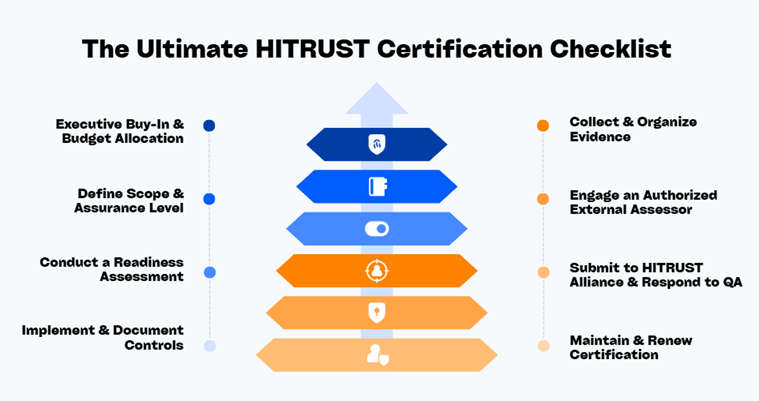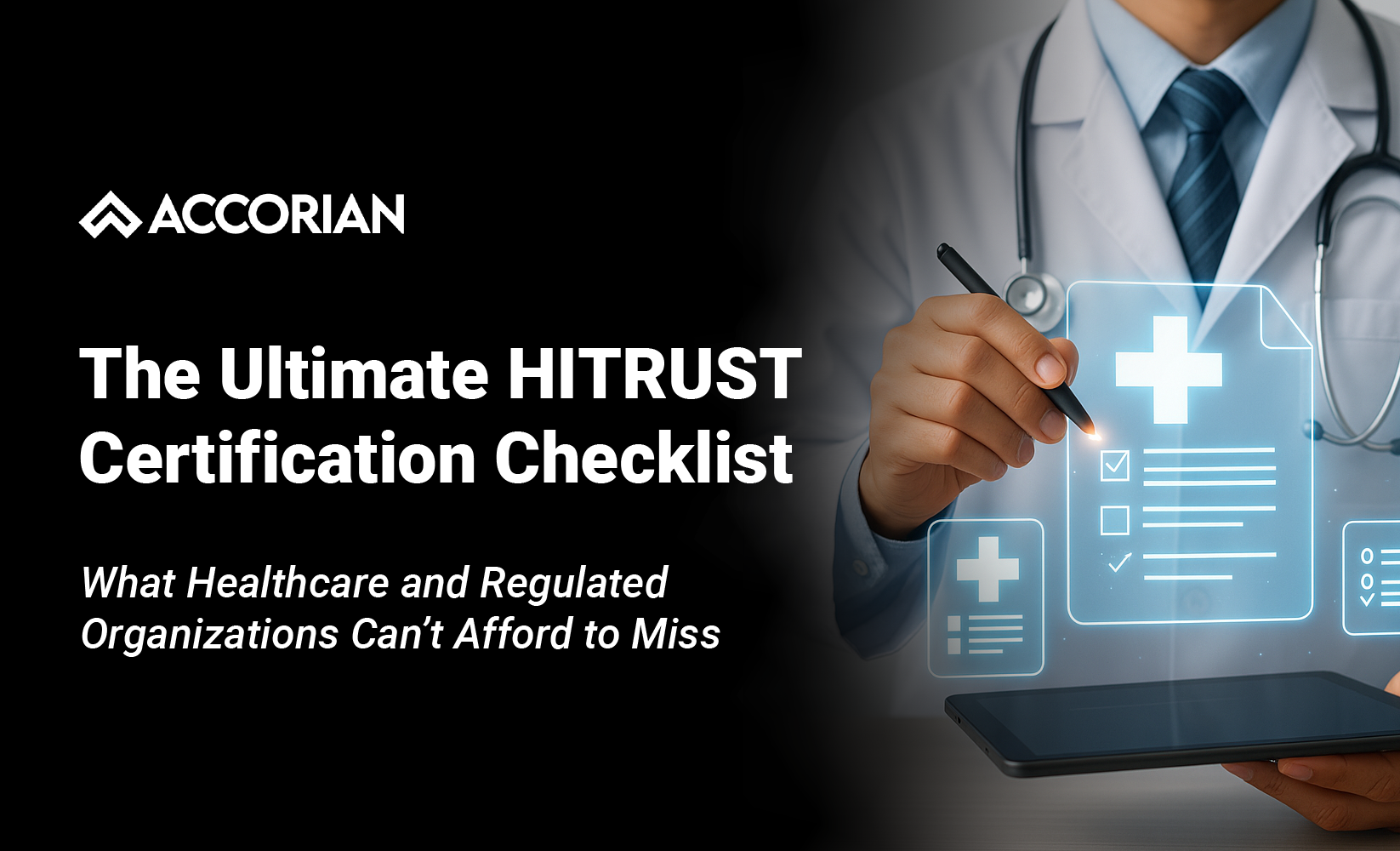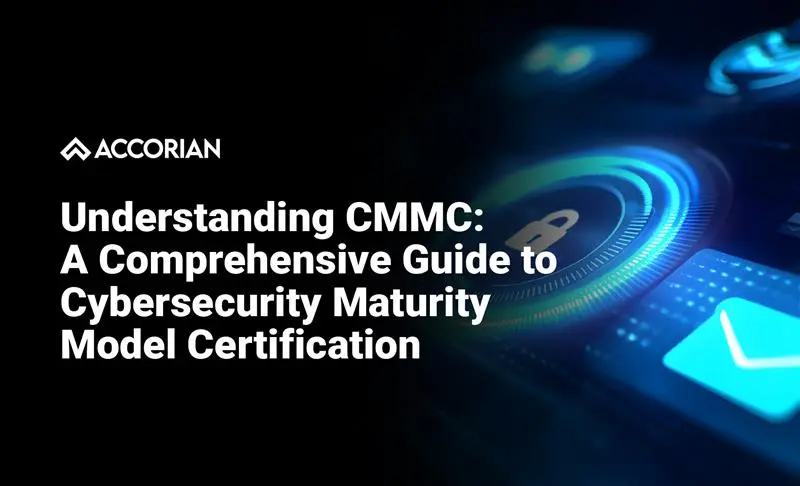Why HITRUST Certification Is No Longer Optional
In today’s high-risk, high-regulation environment, cybersecurity isn’t just a technical concern but a strategic business priority. For healthcare providers, fintech platforms, and other organizations handling sensitive data, HITRUST certification has become the gold standard for demonstrating trust, compliance, and resilience.
But here’s the catch: achieving HITRUST certification isn’t a one-step process. It requires a structured, well-executed roadmap, and missing even one step can delay your certification, increase costs, or jeopardize your audit outcome.
If your organization is serious about protecting data, winning enterprise clients, and staying ahead of regulatory demands, this HITRUST certification checklist is your starting point.
What Is HITRUST CSF?
HITRUST CSF (Common Security Framework) is a certifiable, risk-based cybersecurity framework that integrates multiple standards, including HIPAA, NIST, ISO 27001, GDPR, and PCI-DSS, into a single, harmonized model. It’s designed for organizations in highly regulated sectors that need to prove their security posture across multiple compliance domains.
HITRUST isn’t just about passing an audit; it’s about building a culture of security, trust, and continuous improvement.
HITRUST Certification Checklist: Step-by-Step Breakdown

1. Executive Buy-In and Budget Allocation
Before diving into controls and assessments, secure leadership support. HITRUST certification requires time, resources, and cross-functional collaboration. Without executive sponsorship, progress stalls.
Tip: Frame HITRUST as a strategic enabler and not just a compliance cost.
2. Define Scope and Assurance Level
HITRUST offers three assurance levels:
- e1: Entry-level for low-risk environments
- i1: Intermediate for moderate-risk organizations
- r2: Rigorous for high-risk, high-regulation sectors
Choose the level that aligns with your risk profile, client expectations, and regulatory exposure.
Insight: Many enterprise clients now require r2-level certification. Choosing a lower tier may limit your market access.
3. Conduct a Readiness Assessment
A readiness assessment identifies gaps between your current controls and HITRUST CSF requirements. It’s the foundation for a successful certification journey.
Key Deliverables:
- Gap analysis
- Remediation roadmap
- Control maturity scoring
Pro Tip: Partner with a HITRUST Authorized External Assessor like Accorian to ensure accuracy and efficiency.
4. Implement and Document Controls
This is where the heavy lifting happens. You’ll need to implement technical, administrative, physical safeguards and document them thoroughly.
Focus Areas:
- Access controls
- Encryption and data protection
- Incident response
- Vendor risk management
- Policy and procedure documentation
Insight: Incomplete documentation is one of the top reasons certifications get delayed or denied.
5. Collect and Organize Evidence
HITRUST requires detailed evidence to validate control implementation. This includes screenshots, logs, policies, training records, and more.
Checklist Tip: Create a centralized repository for audit artifacts to streamline submission.
6. Engage an Authorized External Assessor
Only HITRUST-approved assessors can validate your environment and submit your assessment to the HITRUST Alliance. Choose a partner with deep domain expertise and a proven track record.
Why Accorian: As a HITRUST Authorized External Assessor, Accorian offers end-to-end support to healthcare, fintech, and AI-driven organizations.
7. Submit to HITRUST Alliance and Respond to QA
Once your assessor submits the validated assessment, HITRUST performs a quality assurance review. Be prepared to respond to clarifications or requests for additional evidence.
Timeline: QA review typically takes 6–8 weeks, depending on complexity and responsiveness.
8. Maintain and Renew Certification
HITRUST certification isn’t a one-and-done achievement. It requires ongoing control maintenance, periodic assessments, and continuous improvement.
Insight: Organizations that treat HITRUST as a static goal often fall behind. Those that embed it into their culture stay ahead of threats and competitors.
Why HITRUST Matters More Than Ever
- 99.41% breach-free rate among certified organizations
- Trusted by insurers, pharma, and digital health platforms
- Rapidly growing adoption across AI, fintech, and healthcare sectors
- Streamlined compliance with HIPAA, GDPR, NIST, and ISO 27001
If your organization isn’t pursuing HITRUST, you’re not just missing a certification but a strategic opportunity to lead in trust, security, and market credibility.
Ready to Get Certified?
Accorian specializes in guiding organizations through the full HITRUST lifecycle. From scoping and readiness to evidence collection and audit support, we ensure your certification journey is efficient, effective, and aligned with your business goals.
Don’t wait until clients demand it. Get ahead of the curve. Let’s make HITRUST your competitive advantage.



